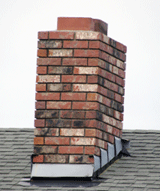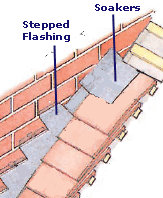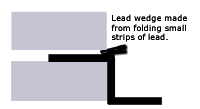This is part 1 of a 2-part project. To view part 2 click here: Lead tray DPC.
The purpose of lead chimney flashing is to form a water proof bridge between the sides, front and back of the chimney and the roof structure and is normally constructed out of lead. Click here to find out more about lead flashing in general.
There are three main factors you must take into consideration when installing lead flashings.
- Water penetration due to the action of gravity
- Water penetration due to the action of wind
- Water penetration due to the action of surface tension with water
If you are installing lead flashings to a chimney you always need to start at the lowest point of the visible chimney above the finished roof. This is because gravity obviously takes water downwards, so the top part of any joint should overlap the section underneath, as with roof tiles themselves.
Apron Flashing
The purpose of the front lead apron is to make the joint between the chimney and finished roof water tight.
Whether your finished roof is constructed from tile or slate the procedure for installing your front apron will be the same.

Apron and stepped flashing to chimney
Your front lead apron will need to be cut into a mortar course of your brick or stone chimney so when cutting your apron you will need to work out which mortar course you are going to fix into. This will give you the height you need to cut your apron to (normally about 50mm –100mm up the existing chimney). This dimension will help you work out which course to cut out to accept your lead.
The mortar course will need to be chased out to accept the lead apron. You can hire a small angle grinder that comes with a special cutting disc especially designed to remove mortar from mortar courses in one cutting action.
Once you are ready to install your lead apron you will need small folded lead tacks or wedges (you can cut these your self or buy pre-made ones) to hammer into the cut out mortar course to hold the apron in place till it is ready to be pointed or sealed permanently into position. The lead apron will also need to return up both sides of the chimney. These returns will eventually be covered by the side stepped lead flashings when they are installed making the chimney flashings complete and water tight.
Stepped Lead Flashing
Stepped lead flashings are the flashings which make the side of the chimney water tight; they follow the roof pitch up to the rear of the chimney and return around the rear of the chimney.

Stepped flashing to side of chimney – Image coutesy of the Lead Sheet Association
They are called stepped because they use and are cut into the brick courses of the chimney in increasing height, therefore looking like steps.
The side step lead flashing can be cut from a profile taken, or created in a layer method (counter flashing) so each component of the flashing over laps the other still producing a step looking finished flashing. Thanks to the Lead Sheet Association for the above image. You can also get help for this from our Book, Teach Yourself Basic DIY detailed below.
Both these methods will be water tight but the profile method will give more defence because it is made from just one piece (less opportunity for leaks to occur).

Teach Yourself Basic DIY by DIY Doctor
Whichever method you decide to use the lead flashing should always cover at least 150mm out from the brick surface across the roof tiles or slate.
Before the stepped flashing is done you will need to install a lead soaker that will run out to the side of the chimney across the roof battens and down the roof under the roof tiles to take water away. This is a secondary layer of protection.
Once this part of the lead flashing is in place you can install the stepped lead flashing.
When installing a chimney single step flashing, using individual layers of flashing, it is best to lay your roof tiles and lead flashing at the same time. Each layer of flashing is then covered by the roof tile as you work your way up the side of your chimney. This avoids the need for climbing up and down the roof later. Roof ladders are a must – ladder roof hook kits are available to buy, or hire a proper roof ladder. See our project on ladder safety for more tips.

Lead wedges to hold lead flashing in place
There are also other ways of securing your lead into the chased out mortar courses as mortar pointing may eventually fail due to heat (expanding & contracting) and sun exposure. Mortar might be very good at adhering to masonry but not to smoothed surface lead. There are many sealant products available on the market now that replace the need or use for mortar pointing they are more flexible, heat resistant and bond better to the masonry and lead. They can also be colour coded to match your existing or required finish.

